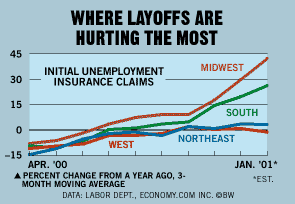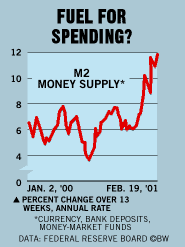Economic Trends
By Gene Koretz

How Economic Pain Will Spread
Every sharp slowdown that has hit
the U.S. in recent decades has had a varying regional impact, and the current
episode is no exception. As a new regional forecast for the current year
from Economy.com Inc., a West Chester (Pa.) consulting firm makes clear,
the malaise that has already struck some areas in the nation's mid-section
could have far more impact on other regions than many people anticipate.
Specifically, the firm predicts
that the high-flying financial and high technology centers in the Northeast
and California will experience significant weakening as the year progresses.
By contrast, the Rocky Mountain economies and much of the South are poised
to hold up relatively well. And the Midwest, already reeling from dramatically
declining manufacturing activity, will remain the nation's weakest region.
So far, notes economist Steven
G. Cochrane, it is the Midwest and the industrial South that have felt
the brunt of the slowdown, as falling manufacturing output has led to rising
layoffs (chart), plant closings, and tumbling sales and business-tax receipts.
In the Midwest, job growth has slowed to a crawl or stopped in such cities
as Detroit, Cleveland, Fort Wayne, and Peoria, while the list of states
facing revenue shortfalls now includes Michigan, Ohio, Iowa, Kansas, and
Missouri. A similar scenario is unfolding in industrial areas in such Southern
states as North and South Carolina, Georgia, Alabama, Kentucky, and Tennessee.
Still, Economy.com believes the
overall Southern economy should hold up well this year, in part because
of upturns in energy-producing areas in Texas, Louisiana, and Oklahoma.
And the Mountain West will remain the nation's strongest region as its
low business costs, housing affordability, and scenic attractions continue
to attract migrating households and businesses.
The biggest changes will occur
in the Northeast and California, which is already wrestling with an energy
crisis. Both areas will begin to experience a marked drop in income growth
as a result of cutbacks in the financial-services industry, waning capital-gains
and stock-option income, dot-com failures, and the telecommunications slowdown.
But it is the less resilient Northeast, says Cochrane, that will take a
larger hit.
All of this assumes the economy
skirts a recession and posts about 2% growth this year. If a downturn does
occur, Economy.com predicts that the New York City and southern New England
areas would suffer even more--as would the already distressed industrial
areas of the Midwest and South. "Even a mild recession," adds Cochrane,
"would leave few regions unscathed."



A Money-Supply Dividend?
The money supply has exploded to
the upside, with the widely watched M2 measure rising at a 12% annual rate
over the past three months. While some see this as simply a reflection
of the public's flight from equities into cash rather than as a harbinger
of stronger economic activity ahead, economist Paul Kasriel of Chicago's
Northern Trust Co. isn't so sure.
The last time M2 surged at a similar
pace, he notes, was in late 1998 in the wake of a Russian bond default,
the foundering of Long-Term Capital Management, and a sinking stock market.
And though economic observers downplayed the money surge at the time, domestic
demand in 1999 proved far stronger than anyone anticipated.
Could it happen again? Since 1995,
Kasriel reports, the correlation between year-over-year growth in real
(inflation-adjusted) M2 and real domestic demand nine months later has
been an impressive 91%--suggesting that demand could well prove relatively
robust later this year. "I wouldn't count the money supply out," he says.



More Trade, More Nations
The last half-century has seen
both increased globalization of markets and an explosion in the number
of nations--from 74 in 1946 to 192 in 1995. While the latter can be attributed
to decolonization and growing nationalism, a study in the American Economic
Review suggests that the two trends go hand in hand--that liberalized
trade has, in fact, made nation-building possible.
In the study, Alberto Alesina of
Harvard University, Enrico Spolaore of Brown University, and Romain Wacziarg
of Stanford University Graduate School of Business argue that nations with
large linguistic and cultural minorities face heavy costs spawned by infighting
over resources. When trade barriers are high, they claim, these costs are
outweighed by the benefits of maintaining large internal markets and greater
resource availability. But when trade between nations is open, it becomes
increasingly possible for small, ethnically compact nations to thrive via
access to external markets and suppliers.
This thesis sheds light on the
rise and fall in the number of nations since the late 19th century. From
1870 to the 1920s, the economists note, as tariff rates slowly rose, the
number of nations remained stable or decreased--a situation that persisted
during the isolationist 1930s. When trade barriers fell dramatically after
World War II, however, the number of small countries began to multiply--so
much so that today, over half of all nations have fewer people than the
state of Massachusetts.
The authors suggest that this trend
should continue as globalization makes more small nations economically
viable. As for the European Union, they view it as more a loose confederation
of independent states seeking the benefit of harmonized economic policy
and free trade than as a traditional national entity, and they note that
its creation has actually encouraged regional separatists in Britain, Belgium,
Spain, and Italy.

|

